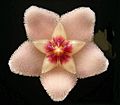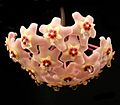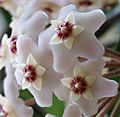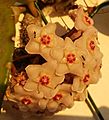Porcelainflower facts for kids
Quick facts for kids Porcelainflower |
|
|---|---|
 |
|
| Scientific classification | |
| Genus: |
Hoya
|
| Species: |
carnosa
|
Hoya carnosa, the porcelainflower or wax plant, is an asclepiad species of flowering plant in the dogbane family Apocynaceae. It is one of the many species of Hoya that are native to Eastern Asia and Australia. It is a common house plant grown for its attractive waxy foliage, and sweetly scented flowers. It is grown well in pots and hanging baskets.
Hoya carnosa has been in cultivation for more than 200 years and has given rise to many cultivars that vary in foliage form or flower color. In cultivation in the UK it has gained the Royal Horticultural Society’s Award of Garden Merit.
Description
Hoya carnosa makes faintly succulent shoots with smooth, pale gray, and bare surfaces that twine and climb. The perennial leaves are stalked with about 1 to 1.5 cm long stems. The blade is wide oval to longitudinal oval or heart-shaped. The leaves are slightly succulent, fleshy with a waxy glossy surface. The leaves, ovate or elliptical, are 3-5 cm wide and 3.5-13 cm long, with a petiole of about 1-1.5 cm. The spindle-shaped fruits measure 6 to 10 × 0.5 to 1.5 cm.
Flowers
The inflorescence is made up of numerous flowers, hanging or more upright, which are grouped in an umbel. The flowers are typically light pink, but may vary from near-white to dark pink; they are star-shaped, and are borne in clusters that look like tiny wax miniatures. The surface of the flowers is covered in tiny hairs giving them a fuzzy sheen. They are heavily scented and may produce excess nectar that drips from the flowers. The flower crown has a diameter of 1.5 to 2 cm and is whitish to slightly pink coloured.
Like all species of Hoya, H. carnosa flowers from specialised perennial structures referred to as spurs. These appear from the axils of the leaves and stem; flowers may not be produced when the spurs first appear, but in time buds emerge from the tips. Each season new flowers are produced on these same spurs, so they should not be damaged or removed.
The plant flowers from spring to late summer, it can produce umbels of 10 to 50 small star-shaped flowers that mature gradually (2 to 3 weeks) on the same peduncle. The scent is nocturnal with a pheromonal tendency.
Distribution and habitat
This species is found in Queensland, East India, in southern China (Fujian, Guangdong and Yunnan provinces, and Guangxi autonomous region), Taiwan, Myanmar, Vietnam, Malaysia, the Japanese islands of Kyushu and Ryukyu, where it grows in humid subtropical forests, and the Fiji Islands.
Cultivation
This Hoya species prefers bright light, but will tolerate much less. Though it will tolerate low temperatures (but not freezing), the optimal temperature is 60–85 °F (16–29 °C). It can be propagated by air layering or by stem cuttings. It benefits from an open potting medium that allows some air to get to the roots. Typical mixes include large-grade drainage material such as perlite, pumice, or ceramic balls. The plants should be fed regularly with a fertilizer suitable for epiphytic plants.
There is a persistent piece of folklore that hoyas prefer to be potbound - kept in a small pot. It is said that this will hasten flowering.
Studies at the University of Georgia, published in 2009, have shown H. carnosa to be an excellent remover of pollutants in the indoor environment.
Gallery
-
Flower, which looks like a furry starfish
Images for kids
See also
 In Spanish: Flor de nácar para niños
In Spanish: Flor de nácar para niños












